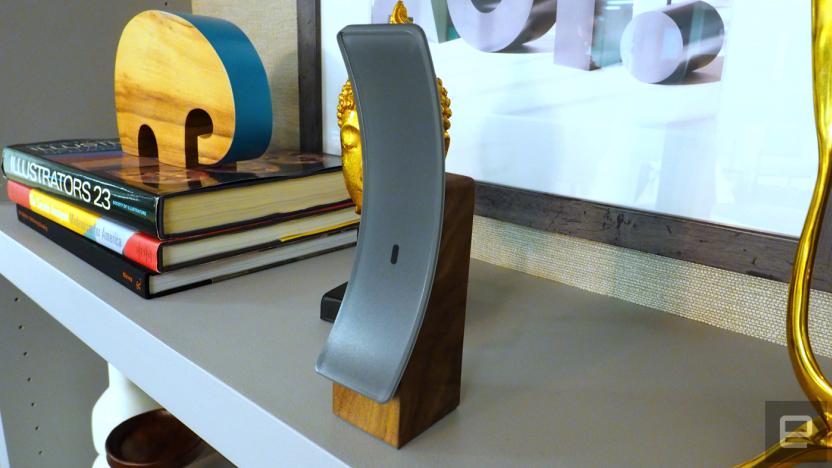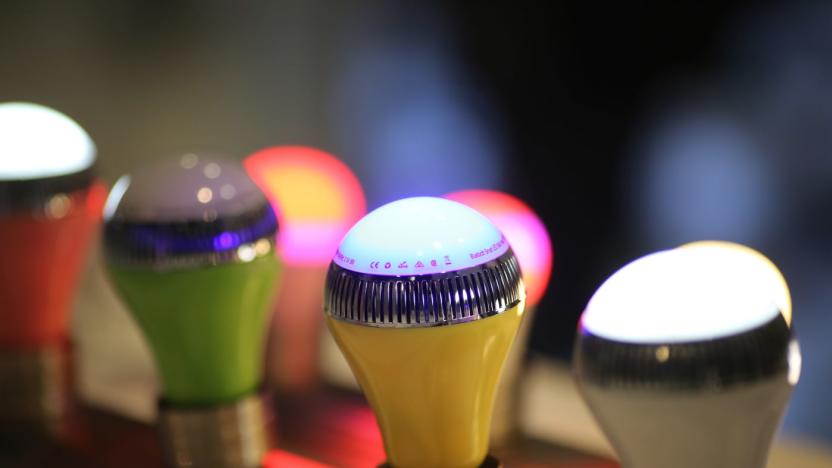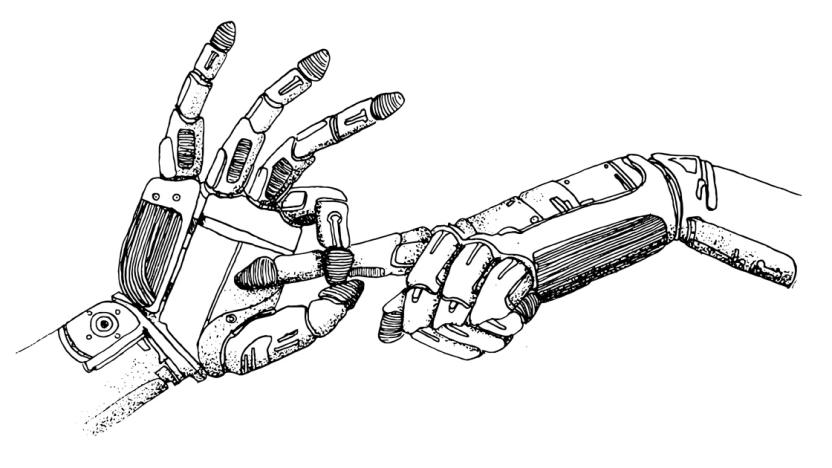InternetOfThings
Latest

The internet of ratings: How makers became hip enough for reality TV
Technology wasn't always hip, and neither was Intel. The company, known for most of its 48-year history as the leader in PC chips, has in recent years branched out into more cutting-edge areas. That includes mobile, drones, robots and an assortment of wearables running the gamut from a high-tech paintball helmet to an augmented-reality hard hat. Now, in a sign of the times, Intel is joining forces with Mark Burnett, the man behind Survivor, Celebrity Apprentice and The Voice, to bring you a reality show about inventors. America's Greatest Makers, which premieres April 5th on TBS, follows 24 teams competing for a $1 million prize. Though the show follows a format similar to other reality contests, complete with auditions (pitches), guest judges and elimination rounds, the panelists are generally friendlier. Think: the NBA's Kenny Smith and celebrity dealmaker Carol Roth, not a Simon Cowell or Gordon Ramsay.

Nest kills integration with Revolv's smart devices
Google-owned Nest has announced that it will shut down all support for the Revolv smart home hub in May and many customers are up in arms over the news. That's because, come middle of next month, Revolv's $300 smart hubs will stop functioning completely. It's not just that their API will no longer operate, the physical devices themselves will brick, according to a report from Business Insider.

Bosch is building its own Internet of Things cloud network
Like it or not, it looks like the Internet of Things is going to be more than an annoying buzzword or passing fad. The latest proof is that Bosch is offering an end-to-end environment to get your house communicating with the various devices and appliances inside. First up? Building its own cloud service based in Germany, as Reuters tells it. The Bosch IoT Cloud (very creative, I know) has a pretty lofty goal, too: For all of the company's electronics to be IoT-enabled by 2020.

Hive feels the heat after smart thermostat glitch
The Internet of Things can be a wondrous thing -- it allows you to operate your lights using an app, remotely monitor your house and, when it works, intelligently warm it. This last weekend, some owners of the Hive smart thermostat experienced what it's like when the Internet of Things goes bad when an app glitch resulted in their homes being heated to as high as 32℃.

Visa thinks your car should pay for its own fuel
The jury may still be out on the usefulness of the Internet of Things, but payments giant Visa is 100 percent sure it doesn't want to miss out. Today it announced plans to push Visa payments into numerous fields. We're talking "wearables, automobiles, appliances, public transportation services, clothing and almost any other connected device" -- basically, anything that can or will soon connect to the internet.

Microsoft, Samsung and Intel form smart home alliance
The connected home has a huge problem. Very little few of the devices actually talk to one another. Thanks to competing communication protocols and companies creating proprietary ecosystems that only let their products talk to one another, users are forced to open multiple apps to have the home of the future. So some big names in tech are hoping to solve the fragmentation issue by forming an IoT alliance called the Open Connectivity Foundation. It's like the Super Friends but for smart bulbs.

Silk Labs Sense: Not your typical home monitoring camera
As useful as Nest's Dropcam is, it isn't the best looking home monitoring camera. Still, there aren't many of them that do a better job design-wise. Silk Labs, a startup founded by Mozilla's former CTO, Andreas Gal, sees this as an opportunity to offer something different. Enter Sense, which is similar to Dropcam in functionality but also comes with a few notable differences. For example, it's said to be smart enough to recognize multiple faces; that can be used to let you know if it thinks a stranger is in your home, or play music based on a particular individual's taste.

You'll soon track Bluetooth devices directly over the internet
There are plenty of Bluetooth-based sensors and smart household items, but they have one big gotcha: they typically need an intermediary device to get internet access and offer control away from home. The Bluetooth standards group has unveiled an architecture that gives those devices an internet gateway without requiring a phone, tablet or another in-between gadget. Your internet-connected thermostat could control temperature sensors around the house and send that information online, letting you track them from wherever you happen to be.

Particle's Electron board lets anyone make 3G internet devices
As sweet as it might be to dream of making your own Internet of Things device, there's one big problem: keeping it online at all times. How do you connect that smart sensor in your backyard when it's nowhere near WiFi? Particle (aka Spark) thinks it can help. It just started shipping the Electron, its cellular-equipped tinkerer's board, to its Kickstarter backers. The tiny device not only has the basic components you need to make IoT gadgets, but a modem (a 2G Electron is $39, 3G is $59) and a simplified, if slightly costly, data plan. If you're willing to spend $3 per month for 1MB and 99 cents for every megabyte afterwards, your project gets online in 100 countries around the world -- not trivial, but just fine if you're building a meter or anything else that transmits only a tiny amount of data.

A first-hand quest for the future of sex, Part 2: Mission diverted
I'd just returned from CES, where it was obvious that sex and tech were finally coming together. Despite my rather unfortunate experiences weeks prior, I was feeling inspired. That's when Kiiroo came into my life. Like a serendipitous orgasm harbinger, it promised to take my "sex life to new heights" through teledildonics. Teledildonics is the sex industry's contribution to the Internet of Things, allowing users to remote control vibrators and sex sleeves, sync those toys to VR videos, interact with an adult cam star in real-time, "feel" a long-distance lover and, as I'd come to discover, bring new meaning to one of my favorite internet initialisms: GFY. NSFW Warning: This story may contain links to and descriptions or images of explicit sexual acts. This is the conclusion of a two-part series exploring the future of sex. To read the first installment, click here at your own risk.

Sony buys a chip maker to boost its Internet of Things
You probably don't think of Sony as an an Internet of Things company (unless you count light bulb speakers), but it might change your mind soon. The Japanese tech giant just bought Altair Semiconductor, a chip maker focused on LTE hardware, to put always-available internet connections into more of its devices. It's not saying much about what that future hardware will look like, but the $212 million deal should meld Sony's existing sensor tech (such as camera sensors and navigation) with 4G data to create a "new breed" of gadgets. Don't be shocked if many of Sony's future electronics are always online, even when you're nowhere near a WiFi hotspot. [Image credit: AP Photo/Gregory Bull]

Internet of Things could save lives during Antarctic expedition
Can the internet of things do more than just let your phone control your home's lighting and temperature? It's an idea that Sigfox is putting to the test after revealing that it's equipping an Antarctic research base with its low-power wireless network. Rather than being used to run the facilities' creature comforts, the tech will be used to connect personal GPS trackers onto the team stationed there. It's hoped that the system can be employed to prevent personnel getting separated from each other in the harsh blizzards encountered during expeditions. The only thing we're wondering is how come it's taken until 2016 before someone's been able to get a system like this working in such a dangerous environment.

Intel's latest ads move beyond the PC
There's no doubt that the PC market is in trouble. And for Intel, that's a real problem -- how do you market yourself when your bread-and-butter processor business is on the decline? By showing what else you can do, apparently. Intel is starting an "Experience Amazing" ad campaign where PCs are just one part of the tech giant's larger picture. The promos show off everything from RealSense cameras (adding flair to the dance you see above) to a dress with Edison-powered butterflies. "See," the commercials shout, "it's not just a computer chip company!"

Sony's smart light turns on the TV when you enter a room
Sony is launching a connected light that performs a surprising number of chores. The "Multifunctional Light," developed using Toshiba's LED lighting tech, can (of course) output a full spectrum of light to match your mood. When it's connected to your smartphone or other WiFi device, you can also activate it remotely or set it up on a scheduled timer, like most other smart bulbs. That's just scratching the surface of this product, though. It also has built-in motion, luminance, temperature and humidity sensors, along with a memory card slot, infrared controller, speaker and microphone. For a light fixture, that lets it do a ridiculous amount of stuff.

The Internet of Things will be more of the same in 2016
Despite analyst expectations that the so-called Internet of Things will generate as much as $1.2 billion in 2016, the Internet of Things appears to be continuing the same shark-jumping trajectory that we saw at last year's CES. Sure, there have been some rather unique and innovative IoT inventions over the past year, but most manufacturers seem to be content with simply slapping a Wi-Fi or Bluetooth radio onto existing products and calling it a mobile revolution. When it comes to crafting a connected home, IoT remains mired in smart light bulbs, net-connected cameras and wireless speakers. You know, the same sorts of bland, iterative use cases we've been seeing since the term was first coined.

Samsung's home tech will eventually plug into Windows 10
Microsoft has revealed that it will join forces with Samsung to develop smart home "internet of things" (IoT) devices that work on Windows 10. The idea is to let people monitor and control washing machines, refrigerators and other appliances using apps on Microsoft's OS. To demonstrate the idea (below), Microsoft used Cortana to query whether a Samsung washing machine was in use and then brought up a chart showing when and how different family members used it.

LG home automation hub gives you pro-level security
It's no longer difficult to find both home automation and security in a single package, but LG thinks it can one-up its rivals with something special... if a bit odd-looking. Its previously previewed Smart Security device may look like an upscale colander, but it serves as both a smart home hub (for Bluetooth, WiFi, Z-Wave and Zigbee) and a wide-angle security camera backed by ADT. It's already equipped to notify you when there's unusual movement or changes in temperature, but a $20 ADT Canopy subscription will get you all-day monitoring with a dedicated response team. In theory, you won't have to bend over backwards to get help if there's a break-in.

ASUS' latest Chromebook is rugged enough for kids
ASUS made a name for itself in the crowded Chrome OS scene with the Chromebook Flip, and now it's ready to bring that design know-how to the classroom. The company's new Chromebook C202 is tailor-made to survive the kind of abuse you'd expect in schools. It has the rugged, drop-resistant body you've seen in rivals, but it's also designed to help out in the event it does break. Its modular body lets you easily replace parts like the battery, keyboard and power socket, and it's easy to tear apart the whole machine with standard tools.

New WiFi standard offers more range for less power
The WiFi Alliance has finally approved the eagerly-anticipated 802.11ah WiFi standard and dubbed it "HaLow." Approved devices will operate in the unlicensed 900MHz band, which has double the range of the current 2.4GHz standard, uses less power and provides better wall penetration. The standard is seen as a key for the internet of things and connected home devices, which haven't exactly set the world on fire so far. The problem has been that gadgets like door sensors, connected bulbs and cameras need to have enough power to send data long distances to remote hubs or routers. However, the current WiFi standard doesn't lend itself to long battery life and transmission distances.

Samsung says its new Tizen TVs will be harder to hack
Samsung has announced that its next generation of Tizen smart TVs will be a lot harder to crack than before. The firm has created Gaia, a security product for its 2016 range that promises to do for TV what Knox did for its smartphones. Some of the features promised include locking your credit card information with a smartphone-style pin, encrypting the data it sends out and a built-in anti-malware system. In addition, the TVs will ship with physical encryption chips to make it that much harder for others to access your microphone or, in some models, webcam.









